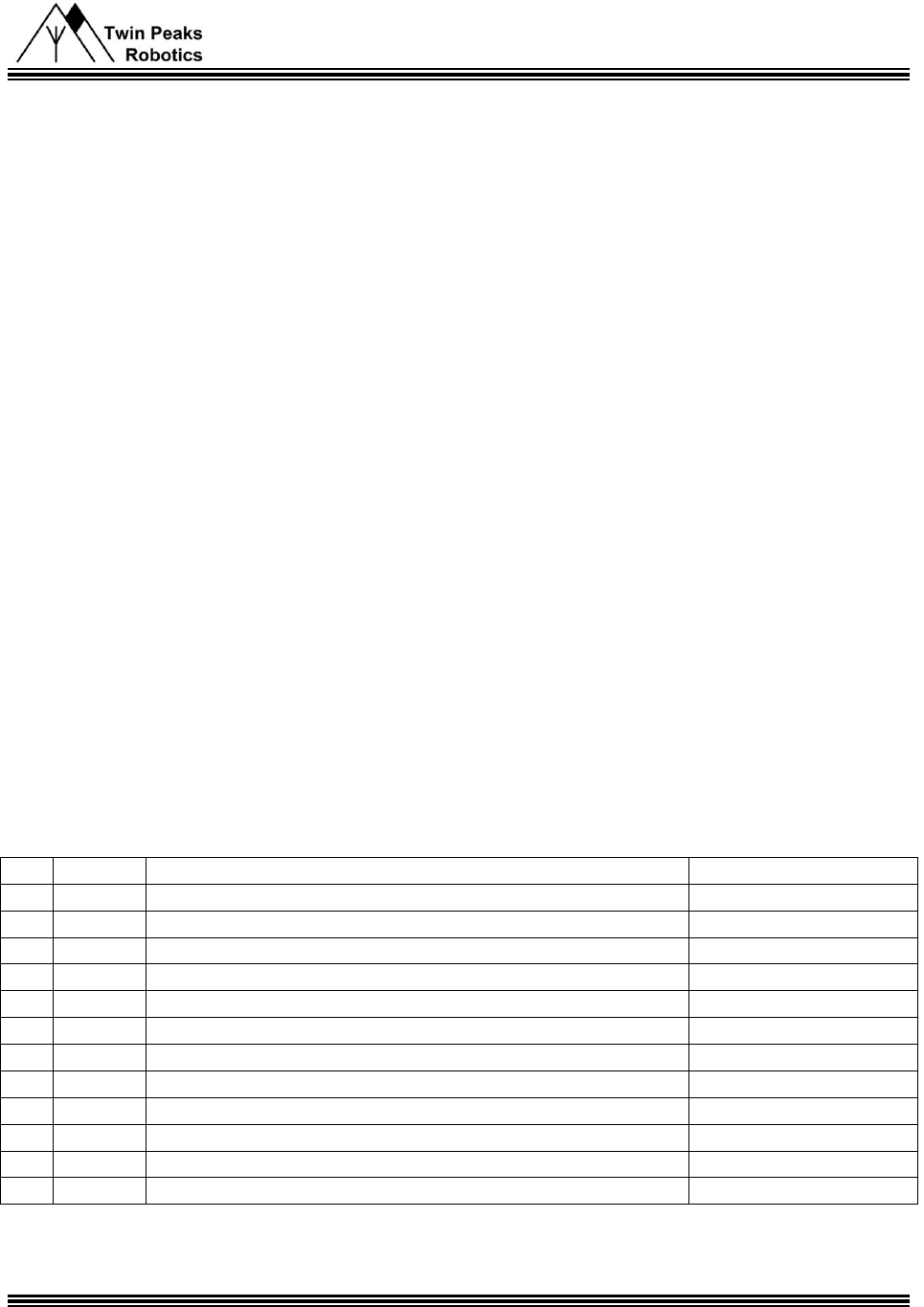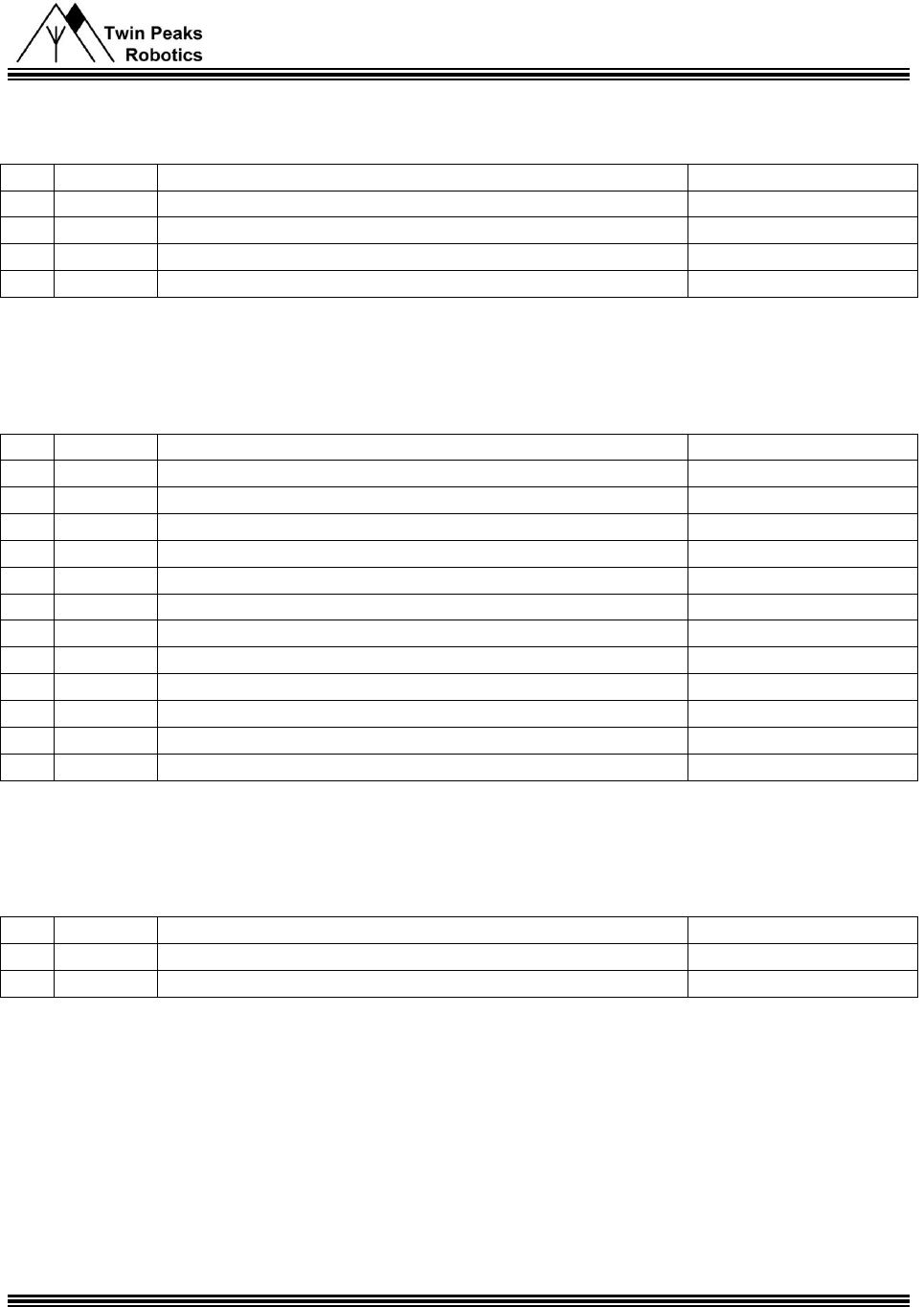Twin Peaks Robotics RRC1-3 Robotic Controller User Manual
Twin Peaks Robotics Robotic Controller Users Manual
Users Manual

RADIO ROBOTICS CONTROLLER
BOARD USERS GUIDE

© 2010 Twin Peaks Robotics pg. 2
RADIO ROBOTICS CONTROLLER BOARD
USER’S GUIDE
1 Introduction
1.1 Overview
The Radio Robotics Controller (RRC) utilizes a ©Microchip PIC24FJ256GB106 integrated with a ©Texas
Instruments CC1101 low-power radio transceiver to provide a wireless robotics control implementation.
16 MIPS Microchip PIC24FJ256GB106 processor
Power input between 6 and 15 volts
Integral 915MHz Transceiver with built in antenna
USB Controller or USB Device port
28 IO connections for robotics control
IO programmable to support various perperials
1Mbit EEProm
Real Time Clock
Accessory Power of 1 Amp at 3 Volts and 1 Amp at 5 Volts
Low Power Capable
Programmable in C and Assembly, Powerful debuggers available
1.2 Support
If you cannot find the information you need in this document or the associated resources listed at the
end of this document email your question to support@TwinPeaksRobotics.com or
sales@TwinPeaksRobotics.com.
2 Core Features
2.1 Processor
The Microchip PIC is 16-Bit processor clocked at 32 MHz resulting in an instruction rate is 16 MIPS.
Program memory is 256 Kbytes (87,552 instructions). Data memory is 16,384 bytes. For detailed
information about this processor reference the Microchip PIC24FJ256GN110 Family Data Sheet.
2.2 Input Power
Input power to the RRC should be between 6 and 15 volts. Current requirements depend on external
devices to be powered. If reduced functionality can be tolerated input voltages as low as 3 volts can be
used.
2.3 Power Out
Through the use of voltage regulators 3 and 5 volts at 1 amp each are available to power external
devices.

© 2010 Twin Peaks Robotics pg. 3
RADIO ROBOTICS CONTROLLER BOARD
USER’S GUIDE
2.4 Radio
Radio communication is accomplished with a © Texas Instruments CC1101 low-power RF transceiver
operating in the 915MHz ISM band. An antenna is part of the PCB so an external antenna is not needed.
For more information about this IC reference the Texas Instruments CC1101 Low-Power Sub-1GHz RF
Transceiver Data Sheet.
Caution: Any changes or modifications not expressly approved by Twin Peaks Robotics could void the
user's authority to operate the equipment.
2.5 USB
The RRC has a built in USB port that can be configured as a controller or device. In controller mode 5
volts at 500 mA is available to power the USB device.
2.6 EE Prom
The RRC has 1 Mbit of EE Prom. The processor accesses this resource with the system SPI port.
2.7 IO
The RRC has 24 primary and 5 secondary I/O ports that can be used for robotics control. The primary
ports are grouped with a power and ground connection to facilitate connection to sensors. Secondary
ports are just signal lines.
2.8 Peripheral Pin Select
To maximize the availability of peripheral devices 22 of the primary IO ports can be configured as one of:
4 External Interrupts
9 Input Captures
2 SPI Ports
5 Timer External Clocks
4 UARTs
2.9 I2C
Registers x and y can be configured as an I2C port

© 2010 Twin Peaks Robotics pg. 4
RADIO ROBOTICS CONTROLLER BOARD
USER’S GUIDE
2.10 5V Digital IO
All IO pins on the RRC can be configured as digital input or digital output. The PIC 24 is a 3V device. In
order to support 5V digital IO the 12 primary IO connections on the top connector are 5V input tolerent.
The power pin associated with each connection is 5V. By default the signal pin of each connection is 3V
but it can be configured as an open collector output and pulled up to 5V.
2.11 3V Digital IO and Analog Input
The 12 primary IO connections on the bottom connector are 3V only. They can all be configured as
digital input or digital output. 10 of these can be configured as analog to digital input.
2.12 Secondary IO Ports
The 7 secondary IO ports do not support peripheral pin select.
3 IO Ports
The RRC has for banks of IO ports. At the top of the card there are 12 primary connections. Just these
are 4 secondary connections. Primary connections are sets of three pins running top to bottom
consisting of a signal, power and ground connection. The signal pin is always on the inside of the board.
The power pin is always in the middle and the ground is closest to the board edge Secondary
connections are just signals. All connections are located on a .1 inch grid. At the bottom of the board
there are another 12 primary connections. Just above them are two secondary. The PIC register
associated with the connection is printed next to the connection.
3.1 Top Primary Connector
Pin
Register
Capabilities
1
G9
RP27/PMA2/C2INC/CN11/RG9
2
G8
PMA3/RP19/C2IND/CN10/RG8
3
G7
RP26/PMA4/C1INC/CN9/RG7
4
G6
PMA5/RP21/C1IND/CN8/RG6
5
E3
PMD3/CN61/RE3
6
E2
PMD2/CN60/RE2
7
D5
PMRD/RP20/CN14/RD5
8
D4
PMWR/RP25/CN13/RD4
9
D3
RP22/PMBE/CN52/RD3
10
D2
DPH/RP23/CN51/RD2
11
D1
RP24/VCPCON/CN50/RD1
12
D8
RP2/DMLN/RTCC/CN53/RD8

© 2010 Twin Peaks Robotics pg. 5
RADIO ROBOTICS CONTROLLER BOARD
USER’S GUIDE
3.2 Top Secondary Connections
Pin
Register
Capabilities
1
E5
PMD5/CN63/RE5
2
E1
PMD1/CN59/RE1
3
E4
PMD4/CN62/RE4
4
E0
PMD0/CN58/RE0
3.3 Bottom Primary Connector
Pin
Register
Capabilities
1
B5
PGEC3/RP18/VBUSON/C1INA/AN5/CN7/RB5
2
B4
PGED3/RP28/USBOEN/C1INB/AN4/CN6/RB4
3
B0
PGED1/RP0/PMA6/VREF+/AN0/CN2/RB0
4
B2
VMIO/RP13/C2INB/AN2/CN4/RB2
5
B8
RP8/AN8/CN26/RB8
6
B9
PMA7/RP9/AN9/CN27/RB9
7
B12
TCK/PMA11/AN12/CTED2/CN30/RB12
8
B14
CTPLS/RP14/PMA1/AN14/CN32/RB14
9
B15
RP29/PMA0/AN15/REFO/CN12/RB15
10
F4
PMA9/RP10/SDA2/CN17/RF4
11
F5
PMA8/RP17/SCL2/CN18/RF5
12
F3
RP16/USBID/CN71/RF3
3.4 Bottom Secondary Connections
Pin
Register
Capabilities
1
B10
TMS/PMA13/AN10/CVREF/CN28/RB10
2
B11
TDO/AN11/PMA12/CN29/RB11

© 2010 Twin Peaks Robotics pg. 6
RADIO ROBOTICS CONTROLLER BOARD
USER’S GUIDE
4 Software Development
4.1 Integrated Development Environment
4.2 Compiler
4.3 Debug and Programming
4.4 Device Drivers
To facilitate application development a library of device drivers has been developed. These are
summarized in Table 3.0 below.
Driver
Description
Compatible Hardware
Radio
Integrated RRC 915MHz ISM digital radio
RRC
USB_Joystick
USB Master Joystick Controller
Dell Mouse
Logitech Attack3
Logitech Extreme3D
USB_Serial
USB Device RS232 Port
Any RS232
Table 3.0 – RRC Device Drivers
5 Sources of Additional Information
5.1 Websites
The following web sites contain useful information associated with the Radio Robotics Controller:
www.TwinPeaksRobotics.com
www.Microchip.com
5.2 Documentation
The following documentation should be referenced for additional information:
Microchip Explorer 16 Development Board User’s Guide
6 Definitions and Abbreviations
ISM – Industrial, Scientific, and Medical radio band between 902MHz and 915MHz used by the RRC
RRC – Twin Peaks Robotics Radio Robotics Controller

© 2010 Twin Peaks Robotics pg. 7
RADIO ROBOTICS CONTROLLER BOARD
USER’S GUIDE
USB – Universal Serial Bus